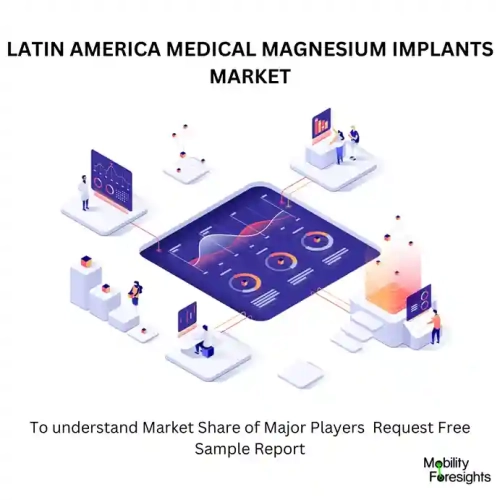
- Get in Touch with Us

Last Updated: Apr 27, 2025 | Study Period:
The Latin America Medical Magnesium Implants Market is growing steadily as the region experiences advancements in healthcare infrastructure, technological innovation, and increasing healthcare demand driven by an aging population. Countries such as Brazil, Mexico, and Argentina are emerging as key markets due to their robust healthcare systems and growing medical tourism sectors. Magnesium implants, which are bioresorbable and designed to naturally degrade in the body, offer an alternative to traditional metal and polymer implants and are gaining traction for use in orthopedic, cardiovascular, and dental procedures.
Magnesium implants are particularly appealing in Latin America due to their cost-effectiveness compared to other advanced implant materials. The regionâs healthcare providers are increasingly adopting these implants to reduce complications, eliminate secondary removal surgeries, and improve patient outcomes. The growing awareness of the benefits of magnesium implants, combined with local efforts to innovate in healthcare technologies, is helping to boost the marketâs overall growth.
Despite the market's potential, it faces challenges such as slow regulatory approvals, high costs associated with new product development, and the need for extensive clinical trials. However, increasing investment from both local and international medical device companies is likely to drive the market forward, with a focus on creating more affordable and accessible implants suited to the regionâs needs.
The Latin America Medical Magnesium Implants Market refers to the adoption of bioresorbable magnesium-based implants for various medical applications. These implants degrade naturally in the body, providing significant benefits over traditional materials such as titanium and stainless steel. As a result, they are becoming increasingly popular in Latin American countries, particularly in orthopedic and cardiovascular treatments.
The different types of magnesium implants include orthopedic devices like screws and pins, cardiovascular stents, and dental implants. Magnesium's mechanical properties, such as strength and its ability to degrade over time, make it an attractive option for short-term medical procedures where long-term implantation is not necessary.
The benefits of magnesium implants include biocompatibility, reduced complications, and the elimination of secondary surgeries for implant removal. However, challenges such as the need for controlled degradation rates and high production costs remain. Advances in magnesium alloy technologies are helping to overcome these challenges, allowing for wider adoption in the region.

| Company Name | Product Description | Analyst View |
| BioMex Devices | Magnesium-based bone screws for fracture treatment | Expected to revolutionize bone surgeries in Latin America due to its bioresorbable nature and affordability. |
| CardioMag Brazil | Magnesium stents for cardiovascular applications | Poised to improve patient outcomes by eliminating the need for secondary surgeries; gaining traction in Brazil. |
| MedImplant Argentina | Custom magnesium dental implants for oral surgery | Offers significant advantages in patient recovery, with growing interest in dental clinics across the region. |
| MagTech Mexico | Magnesium alloy rods for pediatric bone fracture repair | Designed to provide better healing in children, early clinical trials show positive results in terms of degradation rates. |
| Orthomedica Solutions | Magnesium plates for spinal surgery | Shows potential for complex spinal procedures, with a focus on minimizing long-term complications and revision surgeries. |
By Product Type:
By Application:
By End-User:
By Country:
| Sr. No | TOPICS |
| 1 | Market Segmentation |
| 2 | Scope of the Report |
| 3 | Research Methodology |
| 4 | Executive Summary |
| 5 | Introduction |
| 6 | Average B2B Price |
| 7 | Regional Analysis and Trends |
| 8 | Impact of Technological Advancements on the Latin America Medical Magnesium Implants Market |
| 9 | Demand Technology Trends in the Industry |
| 10 | Major Key Drivers in the Market |
| 11 | Recent Product Developments |
| 12 | Manufacturing Footprint for Major Players |
| 13 | Recent Orders in the Latin America Medical Magnesium Implants Market |
| 14 | Market Dynamics and Strategic Initiatives |
| 15 | Analysis of Latin America Medical Magnesium Implants Market Initiatives on Market Growth |
| 16 | Impact of Sustainable Practices on Market Trends |
| 17 | Market Size, Dynamics, and Forecast by Product Type, 2024-2030 |
| 18 | Market Size, Dynamics, and Forecast by Application, 2024-2030 |
| 19 | Market Size, Dynamics, and Forecast by End-User, 2024-2030 |
| 20 | Market Size, Dynamics, and Forecast by Country, 2024-2030 |
| 21 | Pricing Strategies and Market Positioning |
| 22 | Competitive Landscape |
| 23 | M&A in the Past 12 Months |
| 24 | Growth Strategy of Leading Players |
| 25 | Market Share of Vendors, 2024 |
| 26 | Company Profiles |
| 27 | Unmet Needs and Opportunity for New Suppliers |
| 28 | Conclusion |